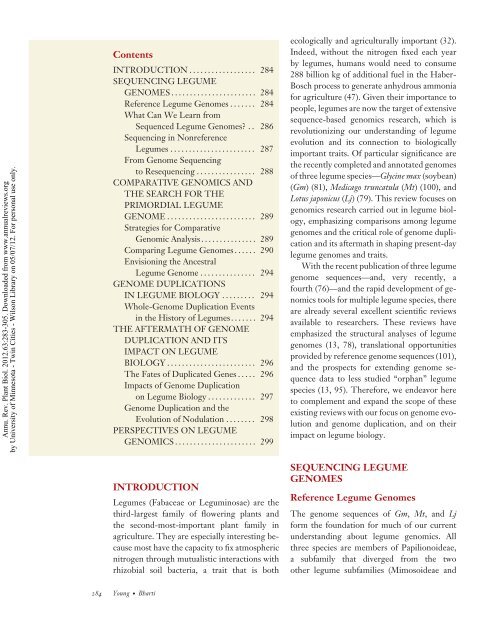Genome-Enabled Insights into Legume Biology - University of ...
Genome-Enabled Insights into Legume Biology - University of ...
Genome-Enabled Insights into Legume Biology - University of ...
Create successful ePaper yourself
Turn your PDF publications into a flip-book with our unique Google optimized e-Paper software.
Annu. Rev. Plant Biol. 2012.63:283-305. Downloaded from www.annualreviews.org<br />
by <strong>University</strong> <strong>of</strong> Minnesota - Twin Cities - Wilson Library on 05/07/12. For personal use only.<br />
Contents<br />
INTRODUCTION.................. 284<br />
SEQUENCING LEGUME<br />
GENOMES....................... 284<br />
Reference <strong>Legume</strong> <strong>Genome</strong>s . . . . . . . 284<br />
What Can We Learn from<br />
Sequenced <strong>Legume</strong> <strong>Genome</strong>s? . . 286<br />
Sequencing in Nonreference<br />
<strong>Legume</strong>s....................... 287<br />
From <strong>Genome</strong> Sequencing<br />
toResequencing................ 288<br />
COMPARATIVE GENOMICS AND<br />
THE SEARCH FOR THE<br />
PRIMORDIAL LEGUME<br />
GENOME........................ 289<br />
Strategies for Comparative<br />
Genomic Analysis . . . . . . . . . . . . . . . 289<br />
Comparing <strong>Legume</strong> <strong>Genome</strong>s . . . . . . 290<br />
Envisioning the Ancestral<br />
<strong>Legume</strong><strong>Genome</strong>............... 294<br />
GENOME DUPLICATIONS<br />
IN LEGUME BIOLOGY . . . . . . . . . 294<br />
Whole-<strong>Genome</strong> Duplication Events<br />
in the History <strong>of</strong> <strong>Legume</strong>s. . . . . . . 294<br />
THE AFTERMATH OF GENOME<br />
DUPLICATION AND ITS<br />
IMPACT ON LEGUME<br />
BIOLOGY........................ 296<br />
The Fates <strong>of</strong> Duplicated Genes . . . . . 296<br />
Impacts <strong>of</strong> <strong>Genome</strong> Duplication<br />
on <strong>Legume</strong> <strong>Biology</strong> . . . . . . . . . . . . . 297<br />
<strong>Genome</strong> Duplication and the<br />
Evolution <strong>of</strong> Nodulation . . . . . . . . 298<br />
PERSPECTIVES ON LEGUME<br />
GENOMICS...................... 299<br />
INTRODUCTION<br />
<strong>Legume</strong>s (Fabaceae or Leguminosae) are the<br />
third-largest family <strong>of</strong> flowering plants and<br />
the second-most-important plant family in<br />
agriculture. They are especially interesting because<br />
most have the capacity to fix atmospheric<br />
nitrogen through mutualistic interactions with<br />
rhizobial soil bacteria, a trait that is both<br />
ecologically and agriculturally important (32).<br />
Indeed, without the nitrogen fixed each year<br />
by legumes, humans would need to consume<br />
288 billion kg <strong>of</strong> additional fuel in the Haber-<br />
Bosch process to generate anhydrous ammonia<br />
for agriculture (47). Given their importance to<br />
people, legumes are now the target <strong>of</strong> extensive<br />
sequence-based genomics research, which is<br />
revolutionizing our understanding <strong>of</strong> legume<br />
evolution and its connection to biologically<br />
important traits. Of particular significance are<br />
the recently completed and annotated genomes<br />
<strong>of</strong> three legume species—Glycine max (soybean)<br />
(Gm) (81), Medicago truncatula (Mt) (100), and<br />
Lotus japonicus (Lj) (79). This review focuses on<br />
genomics research carried out in legume biology,<br />
emphasizing comparisons among legume<br />
genomes and the critical role <strong>of</strong> genome duplication<br />
and its aftermath in shaping present-day<br />
legume genomes and traits.<br />
With the recent publication <strong>of</strong> three legume<br />
genome sequences—and, very recently, a<br />
fourth (76)—and the rapid development <strong>of</strong> genomics<br />
tools for multiple legume species, there<br />
are already several excellent scientific reviews<br />
available to researchers. These reviews have<br />
emphasized the structural analyses <strong>of</strong> legume<br />
genomes (13, 78), translational opportunities<br />
provided by reference genome sequences (101),<br />
and the prospects for extending genome sequence<br />
data to less studied “orphan” legume<br />
species (13, 95). Therefore, we endeavor here<br />
to complement and expand the scope <strong>of</strong> these<br />
existing reviews with our focus on genome evolution<br />
and genome duplication, and on their<br />
impact on legume biology.<br />
SEQUENCING LEGUME<br />
GENOMES<br />
Reference <strong>Legume</strong> <strong>Genome</strong>s<br />
The genome sequences <strong>of</strong> Gm, Mt, and Lj<br />
form the foundation for much <strong>of</strong> our current<br />
understanding about legume genomics. All<br />
three species are members <strong>of</strong> Papilionoideae,<br />
a subfamily that diverged from the two<br />
other legume subfamilies (Mimosoideae and<br />
284 Young·Bharti

















